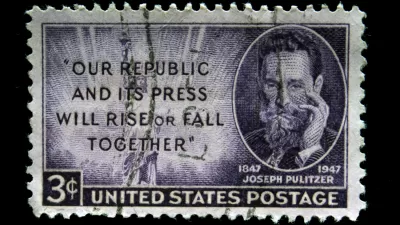The writing of Inga Saffron "makes an ardent plea for more critics willing to take up the mantle of urban citizenship," according to a recent article in The Architectural Review.
Michael Abrahamson begins an analysis of the recent Pulitzer Prize for Philadelphia Inquirer architecture critic Inga Saffron by explaining the significance of the award: "Joining an elite group of only six other architecture writers to have received the coveted prize for excellence in US journalism, Saffron’s critical interest in the architecture of the everyday make her an intriguing Pulitzer laureate."
What is the everyday so significant, according to Abrahamson? "Whereas the pantheon of architecture critics in the UK is filled with travellers and nomads – Pevsner, Meades, Banham and their ilk – there is a contrary tradition in the US of embedded on-the-ground, journalistic writing dealing with the everyday realities of city development and articulating in quotidian language strategies for bettering the urban environment."
As for what makes Saffron so uniquely special, Abrahamson "views her role as less a critic of architecture than of city life, concerning herself not only with the relative quality or deficiency of its built environment but also with the bustling street life and cultural diversity that fascinated another of her obvious forebears, Jane Jacobs."
Abrahamson cites the example of Saffron's stand against the "sub-architectural" "epidemic" of garage-fronted townhouses in Philadelphia in exemplifying the value of her criticism relative to a discussion directed at the city's "shiniest architectural baubles."
FULL STORY: The 2014 Pulitzer Prize Celebrates On-the-Ground Architectural Criticism

Maui's Vacation Rental Debate Turns Ugly
Verbal attacks, misinformation campaigns and fistfights plague a high-stakes debate to convert thousands of vacation rentals into long-term housing.

Planetizen Federal Action Tracker
A weekly monitor of how Trump’s orders and actions are impacting planners and planning in America.

Chicago’s Ghost Rails
Just beneath the surface of the modern city lie the remnants of its expansive early 20th-century streetcar system.

Bend, Oregon Zoning Reforms Prioritize Small-Scale Housing
The city altered its zoning code to allow multi-family housing and eliminated parking mandates citywide.

Amtrak Cutting Jobs, Funding to High-Speed Rail
The agency plans to cut 10 percent of its workforce and has confirmed it will not fund new high-speed rail projects.

LA Denies Basic Services to Unhoused Residents
The city has repeatedly failed to respond to requests for trash pickup at encampment sites, and eliminated a program that provided mobile showers and toilets.
Urban Design for Planners 1: Software Tools
This six-course series explores essential urban design concepts using open source software and equips planners with the tools they need to participate fully in the urban design process.
Planning for Universal Design
Learn the tools for implementing Universal Design in planning regulations.
planning NEXT
Appalachian Highlands Housing Partners
Mpact (founded as Rail~Volution)
City of Camden Redevelopment Agency
City of Astoria
City of Portland
City of Laramie




























